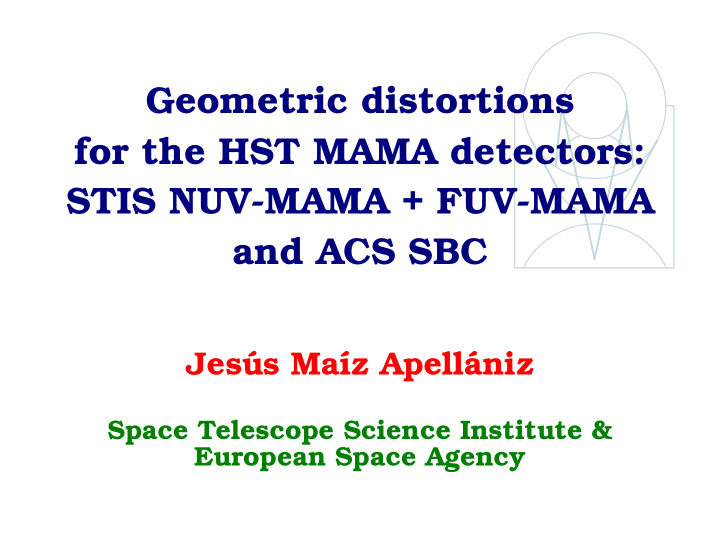



Geometric distortions for the HST MAMA detectors: STIS NUV-MAMA + FUV-MAMA and ACS SBC ız Apell´ Jes´ us Ma´ aniz Space Telescope Science Institute & European Space Agency
1 Description aniz and ´ • We have generated a geometric distortion solution (Ma´ ız Apell´ Ubeda 2004) for the STIS NUV-MAMA and I am currently working on similar solutions for the STIS FUV- MAMA and the ACS SBC, and, possibly, on an improved one for the STIS NUV-MAMA. • There are two approaches to building a geometric distortion solution: Self-calibration Astrometric standard field Description Field with multiple orientations Field with one or several orien- and dithering positions but un- tations and/or dithering positions known coordinates a priori with known precise coordinates Advantages No external data required Simpler approach Disadvantages Many observations required, com- Precise standard field needed, plex analysis, possible skew issues more error sources Examples ACS HRC, Anderson and King STIS NUV-MAMA, Ma´ ız Apell´ aniz and ´ (2004) Ubeda (2004) • High S/N and knowledge of the PSF are required in order to obtain accurate positions in the detector frame. S/N is an issue for MAMA detectors due to count rate limitations. • Few choices for fields of the right brightness, size, and stellar density for MAMA UV observations: globular clusters in our Galaxy or scaled OB associations (SOBAs) at 0.8- 4.0 Mpc.
2 The current NUV-MAMA geometric distortion • Astrometric standard fields: NGC 604 (SOBA in M33, d = 0.84 Mpc, Freedman et al. 2001) and two in NGC 4214 (galaxy with several massive young clusters, d = 2.94 Mpc, Ma´ ız Apell´ aniz et al. 2002, Figure 1). • Reference coordinates were derived from F170W WFPC2 exposures applying the Holtz- man et al. (1995) solution, which has a typical accuracy of 5 mas (Casertano and Wiggs 2001). • STIS NUV-MAMA imaging in three filters (CN182, CN270, and SRF2 for a total of five exposures. • The solution was developed by fitting a fourth-order polynomial degree and appears to be filter independent (Figure 2). • The typical accuracy is 10 mas. • The mean scale of the NUV-MAMA is 24.536 ± 0.027 mas/pix in the x direction and 24.795 ± 0.031 mas/pix in the y direction. • The geometric distortion solution was implemented in the pipeline on 29 October 2003 and is currently in use.
MAMA 1 PC 2 MAMA 2 PC 1 Figure 1. Mosaic with the two F336W PC orientations for one of the NGC 4214 fields with the outline of the two corresponding STIS NUV-MAMA orientations. Circles indicate the lower left corner of the detector for each of the four orientations.
Figure 2. Distortion map for the STIS NUV-MAMA. Each vector represents the distortion in pixels magnified by 50. The dot shows the uncorrected position and the vector the correction to the geometrically correct position.
3 New geometric distortion solutions • Two new astrometric standard fields for the MAMA geometric distortion solutions have been generated from ACS HRC F220W observations. The HRC solution has a typical accuracy better than 0.2 mas, which is more than an order of magnitude better than the Holtzman et al. (1995) solution for the WFPC2. • The first one (NGC 604, Figure 3) was already used for the STIS NUV-MAMA. 20 F220W exposures have been obtained under HST program 10722 to generate the standard field. • The second field (NGC 6681, Figure 4) is a globular cluster at a distance of 9.0 kpc (Harris 1996). 56 F220W exposures obtained under HST programs 9010, 9019, 9565, 9655, 10047, and 10373 were retrieved from the archive to generate the standard field. • The ACS SBC geometric distortion solution will be generated using 12 positions (each one observed with the F122M, F150LP, and F165LP filters) in the first field using data obtained under HST programs 10419 and 10722; and a total of 230 exposures (using the F122M, F115LP, F125LP, F140LP, F150LP, and F165LP filters) of the second field obtained under ten different HST programs. • The STIS FUV-MAMA solution will be generated from 110 exposures (using the CLEAR, SRF2, and QTZ filters) of the second field obtained under ten different HST programs. • If a significant improvement over the previous solution is reached, a new STIS NUV- MAMA solution will be generated from 2 exposures (using the SRF2 and CN182 filters) in the first field obtained under HST program 9096 and 110 exposures (using the CLEAR, SRF2, QTZ, CN182, and CN270 filters) obtained under ten different HST programs.
Figure 3. Mosaic with the 20 F220W HRC exposures of the NGC 604 field with the outline of the 12 SBC positions.
ACS SBC STIS FUV−MAMA STIS NUV−MAMA Figure 4. Mosaic with the 56 F220W HRC exposures of the NGC 6681 field. Symbols are used to mark the positions of the MAMA exposures, with many of them corresponding to multiple filters and/or orientations. The field shown is 41 ′′ × 44 ′′ with N towards the top and E towards the left. The field sizes for individual MAMA 35 ′′ × 31 ′′ exposures are (ACS SBC) and 25 ′′ × 25 ′′ (STIS FUV-MAMA and NUV-MAMA).
References Anderson, J. and King, I. R. 2004, ACS Instrument Science Report 2004-15 (STScI: Balti- more) Casertano, S. and Wiggs, M. S. 2001, WFPC2 Instrument Science Report 2001-10 , STScI Freedman, W. L., et al. 2001, ApJ 553 , 47 Harris, W. E. 1996, AJ 112 , 1487 Holtzman, J., et al. 1995, PASP 107 , 156 Ma´ ız Apell´ aniz, J., Cieza, L., and MacKenty, J. W. 2002, AJ 123 , 1307 aniz, J. and ´ Ma´ ız Apell´ Ubeda, L. 2004, STIS Instrument Science Report 2004-01 (STScI: Baltimore)
Recommend
More recommend